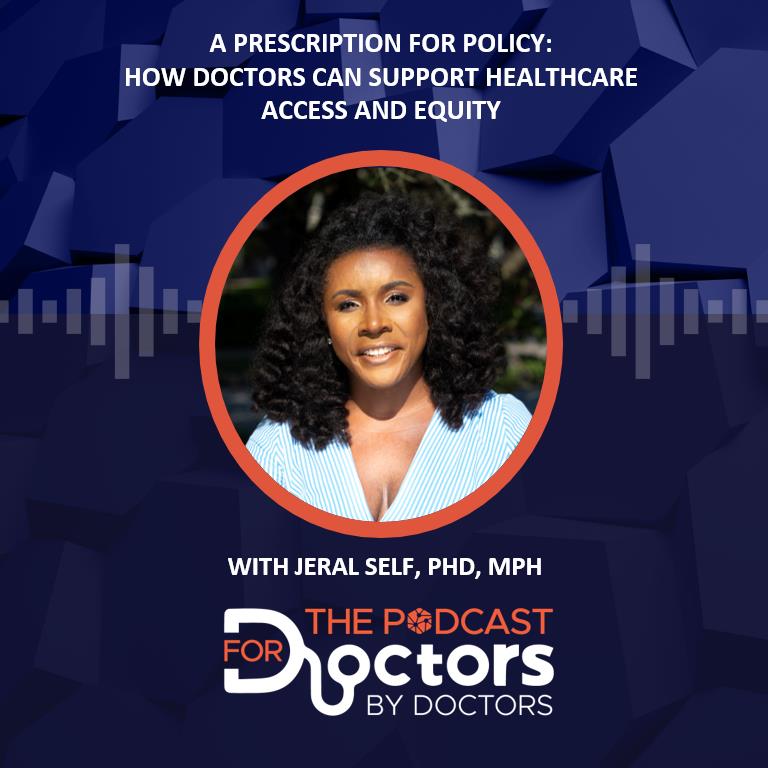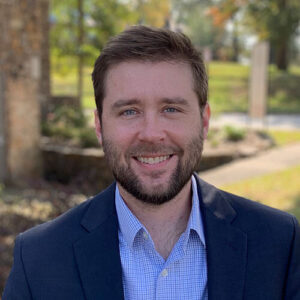Health policy researcher and advocate Dr. Jeral Self joins host Dr. Michael Jerkins to explore one of the most overlooked yet impactful forces in healthcare: policy. With over 17 years of experience, Dr. Self shares what most people, and even many doctors, misunderstand about Medicaid, and why that matters more than ever.
From school-based health initiatives and rural hospital struggles to the rapid rise of telehealth, this episode digs into the real-world effects of policy decisions and the importance of doctor involvement beyond the clinic. Dr. Self also opens up about how motherhood reshaped her perspective on care, and why advocacy can’t be something we only take on after burnout.
How do we make sense of a system as complex as Medicaid? Where can doctors make a difference without a policy degree? And how do we keep patients, especially the most vulnerable, at the center of all this? Whether you’re new to health policy or already active in advocacy, this episode is a thoughtful, personal, and practical look at how doctors can be agents of change in a system that desperately needs it.
Here are four takeaways from the conversation with Dr. Self:
1. Medicaid is Misunderstood—Even by Doctors
Many assume Medicaid is “free money” or only for the unemployed. In reality, it serves working families, young adults, and vulnerable populations—and is often difficult to access and navigate.
2. Policy is Personal
Dr. Self shares how her journey from Mississippi to Boston shaped her passion for public health and how becoming a mother reframed her understanding of care and advocacy.
3. Innovation Must Meet Access
Telehealth, school-based care, and extended postpartum coverage are examples of policy-driven innovations that improve outcomes—but only if reimbursement and infrastructure keep up.
4. Doctors Can—and Should—Advocate
You don’t need a policy degree to make a difference. Sharing what works in your clinic, engaging with associations, and elevating grassroots innovations can influence broader change.
5. Coverage Alone Isn’t Enough
Insurance literacy is critical. Helping patients understand how to use their coverage is just as important as helping them get it in the first place.
Transcript
Jeral Self:
If we solve all the problems in Medicaid, there’s still gonna be issues in Medicare. If we solve the issues in Medicaid and Medicare, we’re still gonna have issues on the private payer side, and then we’re still gonna have people that at the end of the day still don’t have insurance.
Michael Jerkins:
Welcome back to another episode of the podcast For Doctors By Doctors. I’m Dr. Michael Jerkins, and unfortunately, I’m not joined by my co-host, Dr. Ned Palmer today, but I am joined by another doctor—because that’s what we do here on this podcast. I’m very excited about our guest today because it’s someone who adds a different perspective than previous guests with their deep knowledge of health policy, health economics, and all these things that are very complicated and take someone smarter than me to understand.
So I’m very excited today to have Dr. Jeral Self as our guest. Let me give you an amazing introduction of all the incredible work she’s done. Dr. Jeral Self has more than 17 years of experience in health policy research, much of it focused on building and using integrated data from multiple public service systems for the purpose of evaluation for various clients, including the Centers for Medicare and Medicaid Services, also known as CMS; the Assistant Secretary for Planning and Evaluation; and Arkansas and Louisiana’s Medicaid programs.
Her subject matter expertise focuses on vulnerable Medicaid populations, including those receiving home and community-based services, those with behavioral health needs, and individuals experiencing homelessness. She currently serves as a Managing Director for Medicaid Health Policy Research at the Lewin Group, in addition to her role as Head of Community Engagement at Panacea Financial and the Panacea Financial Foundation.
Also worth noting—anything Dr. Self talks about today reflects her opinions alone, not those of her employers. Dr. Jeral Self, pretty exciting stuff, huh?
JS:
Keeps me busy.
MJ:
You have a very impressive introduction. I was like, my gosh, I can’t believe we got you on the podcast. But can you tell us a little bit about your journey in healthcare, what first sparked your interest in the field, and how you landed in this amazing role?
JS:
So growing up, I always knew I wanted to go into a profession of helping people. Growing up in Mississippi, I had a very limited view of healthcare—I thought the only way to give back was through medicine. However, through my life and travels, moving to places like Boston, I learned about other avenues of healthcare like public health. Boston is the mecca for public health services.
I’ve also really been engaged in engineering and STEM from early on. My mom’s an educator and specialized in math, so I was always engaged in math and science. Pivoting from my public health experience in Boston, I decided to go into health economics and more health policy research. And so I’ve been doing that, like I said, for over 17 years now, which seems crazy. I really enjoy the work.
I think that if I would have just been a physician, I would have missed out on some of the larger applications of what I get to do day to day. I appreciate the interactions that physicians have with their patients one-on-one, but the impact I get to have on a macro scale is really meaningful. The analysis I do on a policy could impact hundreds of thousands of Medicaid beneficiaries versus just one patient I might have impacted as a physician.
MJ:
So let me back up a little bit. You went to Boston to study health policy—tell me more about that.
JS:
I moved to Boston to do my master’s in public health at Boston University. While I was there, I got to engage in various different sectors. I worked as a research assistant and later a research director on a clinical diabetes study. I also interned at the Massachusetts Department of Health. Boston’s public health system is really impactful—not only with the various hospital networks but also within their community resources.
Boston has a lot of community health clinics that work closely with the Department of Health. That experience spurred my desire to further my schooling in the area. Ironically, at first, I wanted to do social epidemiology—understanding how social and clinical factors impact people’s outcomes. But one of my professors told me after grading one of my tests that my analytical thought process was more aligned with a health economic researcher than a social epidemiologist.
At the time, I wasn’t quite sure, so I decided to take a step back before going back to school and started working in the field. When I came to Arkansas to work on the Section 1115 waiver—now known as the Arkansas Works program—I got to do data analysis, economic modeling, and evaluation. I really fell in love with that work. And that professor was right—health economics and health policy research were a better fit for my skill set. I’ll never regret that recommendation because I truly enjoy the work I do day to day.
My husband jokes with me all the time—most people dread going to work on Mondays, but I actually enjoy it.
MJ:
Man, so that professor made a big impact on you—and downstream, thousands and thousands of patients. That’s pretty cool. Have you ever talked to that professor and said—
JS:
Sadly, he passed away. But I’m in touch with his family.
MJ:
He had a big impact on a lot of people. That’s amazing. I want to touch on this later, but I think it’s so interesting what you said earlier about your ability to impact thousands. When I see a patient, I see one person, maybe their family. So it’s hard to scale that effort. But you’re saying, hey—I can make recommendations and form programs that really benefit thousands, especially on the Medicaid side.
Did that shift your focus toward Medicaid specifically?
JS:
Growing up in Mississippi, Medicaid is the biggest insurer. So understanding that this was the way a lot of people in my state were accessing care, I always had an interest in Medicaid. Then, knowing my passion for certain communities and my expertise in those communities, I saw overlap—those communities were best served, or currently being served, through Medicaid.
That intersection—my desire to work with maternal health populations, people with behavioral health needs—and Medicaid being the largest payer for those groups just made sense. And then, coming to Arkansas to work on the Medicaid waiver evaluation really solidified it for me.
The joke we always say in the Medicaid world is: “Know one Medicaid program, and you know one Medicaid program.” Every state’s program is so nuanced and different. That complexity and variation sparked my curiosity. Every day is different depending on the state, the population, the policy landscape. That variation is something I really enjoy from an analytics standpoint.
MJ:
I can see now that when you talk about analyzing Medicaid data, you kind of brighten up and start to smile. Clearly you really like what you’re doing—and I’m thankful for that.
JS:
I think it’s important for health researchers and health economists to understand that the numbers we run are not just numbers—they’re people. These individuals have stories, they have needs, they have families, like you said. So what we’re doing holds real weight in terms of the direction healthcare takes.
Knowing that the numbers I’m working with represent the lives of real people really motivates me and pushes me to be the best health economist and researcher I can be.
MJ:
I think this would be a good opportunity for you to educate our doctor listeners on Medicaid. Now that you’ve worked so closely in the space, what do you think most people misunderstand about Medicaid and its role in the U.S. healthcare system?
JS:
I think there are several misconceptions. One is that people on Medicaid aren’t working. But if you look at the data, many Medicaid recipients are single mothers working two or three jobs, just trying to get insurance for their kids. Others are young adults transitioning off their parents’ insurance and don’t have access to employer-sponsored plans yet. Medicaid often fills those transitional gaps in people’s lives.
Another misconception is that Medicaid is just this huge pot of “free money.” In reality, eligibility and enrollment processes are extremely stringent. It’s hard not only to get on Medicaid, but to stay on it. The idea that people are just getting easy access to free coverage is simply not true.
From the provider side, the requirements to be a Medicaid-eligible provider, to bill properly, and to stay in compliance are also very rigorous. It’s not easy money for doctors either.
And then lastly, the idea that all Medicaid programs are the same across the country—it’s just not true. Each state’s program is different. Some are largely rural, some urban. Some have more children than adults in the population. So the policy and program design has to be responsive to those differences. That nuance is critical, but a lot of people don’t see it—and that leads to oversimplified opinions on how Medicaid works.
MJ:
Makes a lot of sense. It’s hard too, because doctors are often just in the weeds with the day-to-day, and it’s sometimes hard for us to really understand what the general population knows—or doesn’t know—about how we engage as doctors, how patients engage with healthcare, and the different systems. So that’s really helpful.
Also, I’ve only worked in three states’ Medicaid programs, and they’ve all been very different—just like you said. There’s so much innovation in healthcare, especially over the past couple of decades. Sometimes it’s cyclical—we think one thing works, then it doesn’t, so we try something else, and then go back to the first thing.
Walk us through some innovations you’ve seen in your experience in healthcare that actually deliver better patient outcomes and better care.
JS:
Even though COVID had its impacts on our country, from the medical perspective it really opened a lot of doors for effective, evidence-based practices to get reimbursed through policy. One of the biggest was telehealth. For continuity of care, especially in rural or underserved communities where getting to a doctor’s office is hard, the reimbursement of telehealth—particularly by Medicaid and Medicare through the COVID Public Health Emergency (PHE)—opened a lot of doors.
It especially helped individuals with unmet or behavioral health needs get care. And I think the continuation of some of those policies after the PHE has really helped maintain continuity of care and address undiagnosed conditions that emerged during that time.
Another innovation has been understanding that when people have healthcare coverage and know how to use it, outcomes improve. A lot of states passing legislation to allow extended postpartum coverage for pregnant individuals has been key—again, helping with access and continuity of care.
On the behavioral health front, two things come to mind. One is expanding flexibilities around prescribing practices. The second is school-based health initiatives. Kids spend most of their day at school—so why not have behavioral health therapists, speech pathologists, social workers, and others in that setting, where services can be reimbursed? When kids leave school, many don’t make it to their appointments. By offering care in the school, we see better outcomes.
We talked about this earlier—doctors in the office can only do so much. Expanding the ways and places that we deliver care has been key since the PHE, and I think that innovation will continue to evolve.
MJ:
I love that. As someone who’s worked in multiple school-based health settings, that’s near and dear to my heart. I totally agree—it’s about bringing the care to where the patients are, especially when things like transportation are barriers.
Some of the great school-based health models I’ve seen include dental, medical, and vision care—like free eye checks and glasses—plus social work and mental health care, all in the school and supported by public health systems. There are a few great examples across the country that really serve as models. But like you said, maybe in some states Medicaid isn’t aligned with school-based health, while others are more supportive.
JS:
I think it comes down to where priorities lie. Every state can’t do everything—some don’t have the budget flexibility. And to change Medicaid policy, especially financing policy, it doesn’t happen at the federal level—it’s at the state level. States only have legislative sessions during specific times of the year.
So if something isn’t prioritized during that session, then no funding gets allocated, and people ask, “Why hasn’t this happened in our state?” Meanwhile, other states moved on it during their session. That’s often the reason for delays.
This is where advocacy becomes important. If a change is going to be prioritized and funded, it has to be on the docket before the session starts. That only happens if there’s enough early advocacy.
MJ:
I want to go back for a second. You talked about telehealth as an innovation. My understanding—correct me if I’m wrong—is that during COVID, telehealth really expanded. I used it a lot to deliver care. But now, many insurances have reduced or even eliminated telehealth reimbursement. Is that true?
JS:
That is correct. But reimbursement has always been an issue, especially with Medicaid. One challenge I work with states on is figuring out reimbursement ranges—understanding that you can’t pay every doctor the same, but finding realistic, incentivizing ranges that make expanding Medicaid panels viable for providers.
Some states find that the necessary rates are too high to fit their budget. So if you can’t raise in-person rates, where else can you move the needle? Telehealth was one of those opportunities. But then, federal mandates required lower reimbursement rates. When that happened, states had to look for other incentives.
For example, patient-centered medical homes often use case management fees—$15 to $30 per patient—to incentivize doctors to keep certain patients on their panel. Some states are now using similar methods to support care coordination or incentivize additional services.
Ultimately, you have to be flexible with reimbursement strategies. Something might work for a time, then a policy shift or change in patient needs will require adaptation. So yes—telehealth reimbursement has gone down in many places, but other mechanisms are evolving in response.
MJ:
The other thing people are talking about now is rural hospitals. You touched on telehealth as a way to reach rural patients. But now, many rural hospitals are closing or are in financial limbo. Can you talk about that and how we should be thinking about these hospitals, especially if funding decreases?
JS:
It’s important to understand that rural hospitals aren’t just funded through Medicaid. They receive additional support through things like Disproportionate Share Hospital (DSH) payments and funds for uncompensated care. But many of the people in those communities are Medicaid recipients—or uninsured. So when someone comes in without any insurance, it adds to the financial burden.
Rural hospitals are often the only accessible provider in a region, but that doesn’t mean they offer full-spectrum services. Policy tries to address this with safety net designations and other tracks, but the increase in closures shows that what we’re doing isn’t enough.
We really need to level set and figure out, from a sustainability perspective, how best to support these hospitals. That might not come from policy or funding alone—there could be other solutions. But without a more extensive evaluation of these closures, we won’t fully understand what’s needed in those communities beyond just increasing reimbursement.
MJ:
And to even get the providers there, right? Exactly. There are some who say there’s a doctor shortage—and numbers can back that up. Others say we actually have enough providers, they just aren’t in the right places. But then, if there’s nowhere for them to practice in rural settings because funding has decreased or the insurance mix has changed, that just exacerbates the problem even more. I think it’ll be interesting to see how that plays out—hopefully in a good way.
You hit on this a couple times when you talked about state legislatures. Their sessions vary and can be very short depending on the state. How do you advise doctors on advocacy? Clearly, we have large national and state associations that advocate for us, which I think are great. But what advice do you have for individual doctors? You know so much about policy and how it all works. A lot of us don’t really get the chance to look up and out—we’re always heads-down in patient care. So what can we do?
JS:
I understand that physicians have competing priorities—and patient care comes first—so advocacy can be hard. Beyond engaging with national groups and voicing your concerns or priorities to those groups, I think there are two other things doctors can do to advocate.
First, look at what’s working in your own clinic. In the insurance sector, there’s been a lot of movement around patient satisfaction and novel practices that providers are doing to improve care. If you’re doing something innovative and it’s showing results, talk to your billing specialist and see if it can be elevated to the insurer or your advocacy group. Sometimes those grassroots-level innovations can be escalated to a national platform.
Second, if you’re seeing evidence-based practices that are reimbursed but don’t actually align with what’s working in your clinic, speak up. Researchers develop these practices, but physicians live them every day. Reach out to researchers or your advocacy organizations to share what is actually working. It’s also important to know that you’re not alone—many providers are likely experiencing the same issue. So by escalating it to a larger scale, you create an opportunity for collective feedback and policy change.
Policymakers sometimes see a concern as isolated unless it’s presented as a broader issue. If 80% of OB-GYNs are having the same problem, that gets attention. So it’s really about organization and amplifying the collective voice.
MJ:
Yes! I have these discussions with large associations—even state and county-level, medical, dental, and veterinary—and I’ve seen a decline in membership among early-career doctors. A lot of them don’t see the value or visibility of what these associations do. Maybe there were past disappointments. But like you said, you’re just one person—and the power is in being organized.
Someone once told me to think of an association as vocational insurance. You’ve got life insurance and malpractice insurance—this is insurance for your profession. We’re all very biased toward protecting how doctors practice, because we believe that’s in the best interest of our patients. That was my soapbox—thanks for letting me step up on it for a second.
Zooming out now—not just Medicaid but U.S. healthcare more broadly—what do you think is the most pressing issue in healthcare right now?
JS:
I think the most pressing issue in healthcare is that we’ve taken some major steps forward—but then we’ve taken 15 steps back. If you look at patient populations, especially maternal and child health, the U.S. has much worse outcomes than many peer countries. And until recently, we hadn’t re-prioritized those issues.
It’s frustrating to see progress in an area, only to have budget cuts or policy reversals undo the gains. Sometimes we see a high price tag and call something inefficient, without appreciating the long-term impact on care continuity and outcomes.
Another key issue is that there’s no single fix. If we solve all the issues in Medicaid, we’ll still have problems in Medicare. If we solve those, we’ll still have issues in private insurance. And even then, we’ll still have uninsured people who need care and providers who aren’t being reimbursed.
Every administration has different priorities and approaches. Until we have a more coordinated, holistic strategy that addresses all payer types and care gaps, we’re going to keep shifting problems from one system to another without actually solving them.
MJ:
Exactly. Everyone wants to fix healthcare—but it’s not a one-solution problem. That said, I’m going to contradict myself with this next question. Let’s just pretend you had a magic wand and could fix one thing in healthcare today. What would it be?
JS:
Coverage and access. We know that when people have insurance—and understand how to use it—they’re empowered, and we see better health outcomes.
It’s not just about giving people insurance. We also have to teach them how to navigate it. I have conversations all the time—even with family—about what coinsurance is, how deductibles work, what’s in-network versus out-of-network. These seem like basic concepts to those of us in healthcare, but for most people, they’re really confusing.
So I’d focus not only on helping people get and keep insurance, but on insurance literacy. I’d also incentivize insurers—Medicaid, Medicare, private—to include that literacy as part of their coverage offerings. It’s not a magic bullet, but it would help reduce a lot of misuse, confusion, and gaps in care.
MJ:
Interesting. And my understanding is that in the dental world—especially for our dental audience—a lot of the recent gains in coverage have come from government insurance like Medicaid and Medicare. Can you talk about how Medicaid and Medicare are helping patients access dental care?
JS:
Yes. We’ve long known that coverage for children’s dental care under Medicaid is critical—but there were a lot of limitations in how that was implemented. For example, many parents thought they had dental coverage for their kids, but it wasn’t actually offered or reimbursed in practice.
Some states have used waiver mechanisms or supplemental programs to expand access, recognizing how important it is. But like with physicians, dentists face a lot of challenges in becoming Medicaid providers—and staying enrolled. It’s not easy.
To ensure continuity of dental care, Medicaid should revisit some of those policy constraints and look at ways to better incentivize dental providers to participate. Because when you compare the number of Medicaid-participating dentists to pediatricians or other child-focused providers, the dental networks are much smaller—even in states with broad coverage for kids.
MJ:
As a pediatrician, I see this all the time. There are so many kids I care for who have no access to a dentist. And at least in some states, it seems like private-practice dentists struggle to maintain Medicaid participation—the paperwork is heavy, the reimbursements are low, and their operating costs are rising.
From what I’ve seen, the dental organizations that can participate in Medicaid successfully are usually large DSOs or group practices. They have the administrative support to handle the paperwork and scale to absorb the lower reimbursement rates. They’re delivering the volume that makes the economics work.
JS:
When we talk about underserved communities—particularly rural communities—they often don’t even have access to basic healthcare providers, let alone dental care. So in those areas, how can Medicaid help support dental access?
Some states have turned to mobile dental clinics and are incentivizing those visits as reimbursable services instead of requiring patients to visit a traditional dental office. Also, dental care is one area where Medicaid and Indian Health Services (IHS) have collaborated, especially recognizing the high dental needs in tribal health populations. Many of these tribal areas overlap with rural communities, so working with IHS to provide services in those regions is another opportunity.
As we’ve discussed, from both a reimbursement and access perspective, we need to be more inventive in how we help beneficiaries get care. Some patients simply can’t get to dental offices or can’t secure appointments. So knowing those barriers exist, we have to create other incentives and pathways for providers to reach those patients in alternative ways.
MJ:
Makes sense. We mentioned your background earlier, but one of the highlights is your work with the Panacea Financial Foundation. Can you tell us more about what the foundation is and why it exists? I know the answer, of course, but I want to make sure our audience hears it.
JS:
The Panacea Financial Foundation was created to help address the underrepresentation of minority students in the medical pipeline. While we can’t solve all the systemic issues, the foundation focuses on three key areas.
First, we provide financial literacy and educational opportunities for students, residents, and fellows in training. Second, we award grants and scholarships to support those same groups. And third, we’re building a mentor-mentee network, because it’s incredibly important for aspiring physicians to see someone who looks like them, is succeeding in their field, and can serve as a sounding board.
That representation and support are essential to helping these individuals thrive and develop as future physicians.
MJ:
And so far, there’s been several hundred thousand dollars awarded through those scholarships and grants, which is incredible. I know we touched on this earlier, but what are some unique ways you’ve seen residents and fellows use that grant money?
JS:
Since the grants aren’t just for tuition, we’ve seen incredibly creative uses. Some awardees have used the funds to travel back to their home countries—like Costa Rica, the Dominican Republic, and across Africa—to serve medically underserved communities where providers are scarce.
Others have used the funds to create educational tools, like children’s books that feature Black and Brown doctors, helping kids in inner-city communities see healthcare role models who look like them. We’ve also supported clinical and practice-based research, with awardees using the funds to study conditions that disproportionately affect underrepresented communities.
Those are just a few highlights from our recent grant cycles, but overall, we’re seeing applicants using the funds in ways that make a real impact both locally and globally.
MJ:
It’s amazing. I always say this because I get to review some of the applications. These individuals are so impressive—many already have their own nonprofits up and running while still in training. Honestly, reading their CVs and essays makes me wonder how I even got into med school! But it’s been amazing to see how the Foundation is supporting a generation of future leaders—some of whom are now serving on the Foundation’s board and continuing to give back.
JS:
And to your point, with the increasing number of applications we receive each year, it shows just how strong the need is. We’re doing our best to address it in a meaningful way.
MJ:
Love it. Okay—switching gears. I’ve got a few rapid-fire, true-or-false questions for you. Just respond with your gut. I don’t think I prepped you for these, so here we go.
True or false: AI will make us healthier as a population.
JS:
False.
MJ:
Why?
JS:
AI is only as good as the information we put into it. There are still many areas of medicine and research where we haven’t fully uncovered root causes or diagnostic patterns. If we rely on AI as the singular source of truth, we risk missing key insights—especially for populations that have historically been underrepresented in the data.
Now, in fields that are well-researched with robust datasets, AI can absolutely be useful. But in less-developed areas or for marginalized communities, it could actually create more harm than good by reinforcing existing gaps.
MJ:
Are people using it a lot now in research—like for data analysis?
JS:
Yes, AI is being used in research, especially for data analysis. But in several recent proposals I’ve worked on for government entities, there’s been explicit guidance cautioning against relying too heavily on AI for areas that require critical thinking. There’s an acknowledgment that AI is a useful administrative and management tool—but it’s not a substitute for nuanced human judgment, especially where the evidence base is limited.
MJ:
And it hallucinates—just makes stuff up sometimes. Interesting. Okay, next one:
True or false: Access to healthcare will improve over the next five years.
JS:
False.
MJ:
Okay, that was a thoughtful pause. Why?
JS:
The economist in me looks at enrollment trends, inflation, and demographic changes. Based on current projections, we’re likely to see a decline in insured populations over the next 2–3 years before things start to improve again. Factors like inflation, the U.S. birthrate, and broader economic conditions all play a role.
MJ:
Interesting—very nuanced. Okay, next one:
True or false: Healthcare costs will continue to increase over time.
JS:
True. Even though there are efforts to implement budgetary restrictions and control spending, I don’t think those efforts are actually improving efficiency. So in the long run, costs will keep rising.
MJ:
Coke versus Pepsi… wait, that’s not a true/false. Okay, true or false: Coke is better than Pepsi?
JS:
I’m a Topo Chico girl, so I’m out on both.
MJ:
For the record, we’re not sponsored by any of those companies. Okay, final question. We end every podcast with this:
We’ve never had more access to information. But when does information actually change our minds? That’s the part I find fascinating. So—what is one thing you’ve recently changed your mind about?
JS:
As a new mom, I used to think “mom brain” was just something my mom said to make excuses or be dramatic. But I’ve completely changed my mind. Mom brain is real. That’s one thing I’ve come to fully believe since having my daughter.
MJ:
Have you called your mom to say, “I get it now”?
This has been awesome. Dr. Jeral Self, thank you for joining us on the podcast, for educating us, and for sharing more about your story. This has been fascinating. Thank you so much for your time.
JS:
I get it now. I get it now.
Thank you, Michael.
MJ:
Thanks for joining us for this episode. You can find the Podcast for Doctors by Doctors on Apple, Spotify, YouTube, and all the major podcast platforms. If you enjoyed this episode or learned something today, please take a moment to give us a rating and subscribe so you don’t miss any future releases.
To submit topic ideas, guest suggestions, or questions, email us at [email protected]. As always, thanks for listening—and the next time you see a doctor, maybe you should prescribe them this podcast. See you next time.
Check it out on Spotify, Apple, Amazon Music, and iHeart.
Have guest or topic suggestions?
Send us an email at [email protected].

Feeling Disappointed On Match Day? What’s Next? – Match Day 2025
According to the NRMP 2024 Main Residency Match Results and Data, less than half of all Match Day applicants were matched with their first choice...

What To Do If I Didn’t Match: SOAP Tips & More
Every year, thousands of medical students apply and interview for residency. In 2024 alone, 50,413 applicants submitted a certified rank order list of their preferred...

What Happens If I Didn’t Match Into A Residency Program?
In 2024, 6.3% of MD seniors and 7.3% of DO seniors were unmatched. If after completing SOAP you are still unmatched, it is important to...




